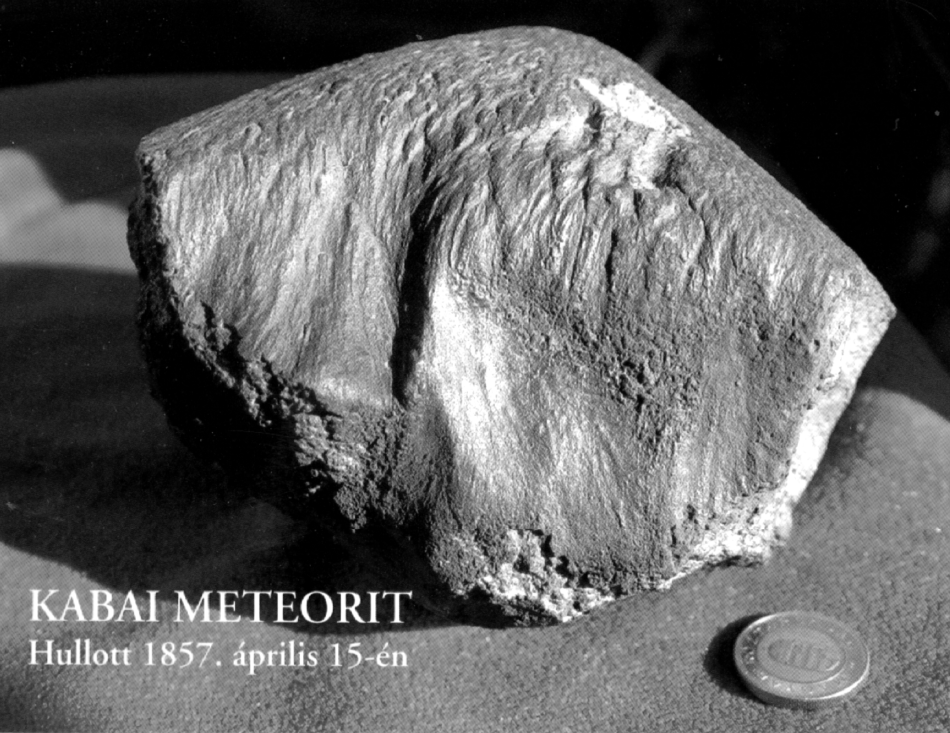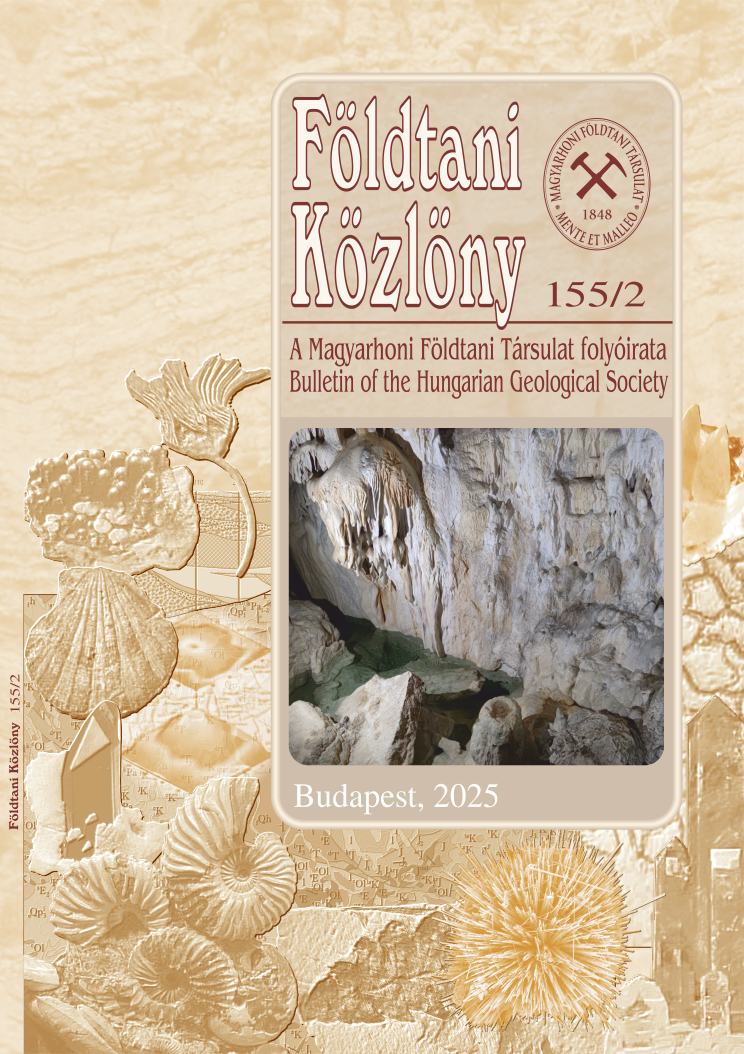The most relevant results found in the re-analysation of the Kaba meteorite
I. Platinium-iridium containing white inclusions, chondrules and chondrule-like formations in the Kaba meteorite
Abstract
In the Kaba meteorite there are various types of refractory minerals and mineral associations. Most of them can be found in white inclusions in the rounded-oval, chondrule-like formations, and in ”chondrules” with a diameter of 100–200 μm. The yellowish-white ”xenolithes” of 10–18 mm length are also visible on the surface of the meteorite, and are composed of irregularly-shaped grainy aggregates. Locally, clusters of CAI-aggregates of various sizes can be observed and these are probably fragments of an originally bigger piece. Their mosaic structure could also be the result of this fragmentation. The aggregates are mostly in the 100–400 μm size range, and their respective compositions are different. They have complex zoning and sometimes they also contain matrix material. Their most frequent phase is Al-spinel, which is predominant in the core but generally can be also found in the outer zones, albeit in a smaller amounts. The main constituents in the outer zones are clinopyroxenes–Al-diopside, fassaite–Ti-fassaite, and gehlenite (albeit in a smaller amounts to the former). The outernmost zone of some aggregates consists mainly of forsterite.
The mineral composition of the rounded-oval, chondrule-like formations, as well as of the small chondrules, is almost identical to the aggregates. However, there are significant differences in the respective formation sequences and proportions of the mineral constituents.
The predominant core-forming phases generally contain inclusions in various proportions: e.g. there are some perovskite and/or spinel in the gehlenite, while spinel contains plenty of perovskite inclusions. In the core of the rounded, cloudy-like aggregate, the mineral is Mg-containing gehlenite. The latter contains a platinum-rich (72%) inclusion with some iridium and hafnium, among others. On these bases, the respective form, structure and mineral composition of the gehlenite, spinel-, normative hercynite-containing, and corundum-containing varieties can be distinguished in the rounded-oval, chondrule-like formations. The characteristic phases of a given variety are generally predominant in the core and have affluent inclusions: e.g. gehlenite contains rounded perovskite, while in the outer zones the inclusion is usually spinel. Perovskite is a characteristic inclusion in the core of the other varieties as well. The zone surrounding the core is mainly composed of spinel and clinopyroxene. In some varieties, however, there is a significant amount of amorphous material (mesostasis) with 5–7% Na2O; the latter occasionally forms a well-defined zone. This zone probably contains (normative) sheet silicates, similar to those found in the Mokoia meteorite by MACPHERSON et al. (1983).
References
BLANDER, M. & FUCHS, L. H. 1975: Calcium-aluminium-rich inclusion in the Allende meteorite: evidence for a liquid origin. − Geochimica et Cosmochimica Acta, 39, 1605−1619. https://doi.org/10.1016/0016-7037(75)90083-6
CLAUS, G. & NAGY, B. 1961: A microbiological examination of some carbonaceous chondrites. − Nature, 192, 594−596. https://doi.org/10.1038/192594a0
COHEN, R. E., KORNACKI, A. S., & WOOD, J. A. 1983: Mineralogy and petrology of chondrules and inclusions in the Mokoia CV3 chondrite. − Geochimica et Cosmochimica Acta, 47, 1739−1757. https://doi.org/10.1016/0016-7037(83)90023-6
FEGLEY, B. & POST, J. E. 1985: A refractory inclusion in the Kaba CV3 chondrite: Some implications for the origin of spinel-rich objects in chondrites. − Earth and Planetary Science Letters, 75, 297−310. https://doi.org/10.1016/0012-821x(85)90174-8
GROSSMAN, L. & GANAPATHY, R. 1976: Trace elements in the Allende meteorite – II. Fine-grained, Ca-rich inclusion. − Geochimica et Cosmochimica Acta, 40, 976−977. https://doi.org/10.1016/0016-7037(76)90145-9
GUIMON, R. K., SYMES, S., SEARS, D.W.G. & BENOIT, P. H. 1995: Chemical and physical studies of type 3 meteorites XII: Metamorphic history of CV chondrites and their components. − Meteoritics, 30, 704−714. https://doi.org/10.1111/j.1945-5100.1995.tb01168.x
HOFFER, A. 1928: A kabai meteorit története (The history of Kaba meteorite). − Debreczeni Szemle kiadv., 1−15.
HOLMEN, B. A. & WOOD, J. A. 1987: Refractory inclusions in the Kaba CV3 chondrite. − Meteoritics, 22, 413.
HUA, X. & BUSECK, P. R. 1995: Fayalite in the Kaba and Mokoia carbonaceous chondrites. − Geochimica et Cosmochimica Acta, 59, 563−578. https://doi.org/10.1016/0016-7037(94)00383-w
KELLER, L. P. & BUSECK, P. R. 1989: Aqueous alteration of the Kaba CV3 carbonaceous chondrite. − Meteoritics, 24, 284−285.
KELLER, L. P. & BUSECK, P. R. 1990: Aqueous alteration of the Kaba CV3 carbonaceous chondrite. − Geochimica et Cosmochimica Acta, 54, 2113−2120. https://doi.org/10.1016/0016-7037(90)90274-o
KORNACKI, A. S. & WOOD, J. A. 1984: The mineral chemistry and origin of inclusion matrix and meteorite matrix in the Allende CV3 chondrite. − Geochim. Cosmochim. Acta, 48, 1663−1676. https://doi.org/10.1016/0016-7037(84)90335-1
KROT, A. N., PETAEV, M. I., RUSSELL, S. S., ITOHC, S., FAGAND, T. J., YURIMOTO, H., CHIZMADIA, L., WEISBERG, M. K., KOMATSU, M., ULYANOV, A. A. & KEILA, K. 2004: Amoeboid olivine aggregates and related objects in carbonaceous chondrites: records of nebular and asteroid processes. − Chemie der Erde, 64, 185−239.
LATTIMER, J. M. & GROSSMAN, L. 1978: Chemical condensation sequences in supernova ejecta. − Moon and Planets, 19, 169−184. https://doi.org/10.1007/bf00896989
LIU, Y. C. & SCHMITT, R. A. 1988: The relative nebular locations for the formation of parental components in the CV3 chondrites, Kaba, Mokoia and Allende. − Lunar Planet. Sci., XIX, 684−685.
LIU, Y. C., SCHMITT, R. A., HOLMEN, B. A., WOOD, J. A. & KRING, D. A. 1988: A trace element/petrographic study of refractory inclusions in Kaba (CV3). − Lunar Planet. Sci., XIX, 684−685.
MACPHERSON, G. J., BAR-MATTHEUS, M., TANAKA, T., OLSEN, E. & GROSSMAN, L. 1983: Refractory inclusion in the Murchinson meteorite. − Geochimica et Cosmochimica. Acta, 47, 823−839. https://doi.org/10.1016/0016-7037(83)90116-3
MCGUIRE, A. V. & HASHIMOTO, A. 1989: Origin of zoned fine-grained inclusions in the Allende meteorite. − Geochimica et Cosmochimica Acta, 53, 1123−1133. https://doi.org/10.1016/0016-7037(89)90218-4
MCSWEEN H. Y. 1977: Petrographic variations among carbonaceous chondrites of the Vigarano type. − Geochimica et Cosmochimica Acta, 41, 1777−1790. https://doi.org/10.1016/0016-7037(77)90210-1
MEINSCHEIN, W. G., NAGY, В. & HENESSY, D. J. 1963: Evidence in meteorites of former life. − Ann. New York Acad. Sci., 108, 553−579. https://doi.org/10.1111/j.1749-6632.1963.tb13408.x
NAGY B. 1968: Indications of possible biological substances in carbonaceous meteorites. − J. Astronautical Sci., 15, 161−168.
NAGY B., MEINSCHEIN, W. G. & HENNESSY, D. J. 1961: Mass spectrometric analysis of the Orgueil meteorite: evidence for biogenic hydrocarbons. − Ann. New York Acad. Sci., 93, 27−35. https://doi.org/10.1111/j.1749-6632.1961.tb30508.x
NAGY, L. A., KREMP, G. O. W., & NAGY, B. 1969: Microstructures approximating hexagonal forms (and of unknown origin) in the Orgueil Carbonaceous Meteorite. − Grana Palynologica, 9/1−3, 110−117. https://doi.org/10.1080/00173136909436428
NAGY M. 2008: A kabai meteorit (The meteorite of Kaba). − Debreceni Református Kollégium, 5−78.
PECK J. A. 1983: Chemistry of CV3 matrix materials and Allende chondrule olivine. – Abstract, Meteoritics, 18, 373−374.
PECK J. A. 1984: Origin of the variation on properties of CV3 meteorite matrix and matrix clasts. − Lunar Planet. Sci., XV, 635−636.
RUBIN A. E. 2012: Impact-induced aqueous alteration of CM and CV carbonaceous chondrites. − Lunar Planet. Sci. Conference 43rd, 1058.
SZTRÓKAY K. I. 1959: The application of X-ray analysis to the study of meteorites. − Annales Universitatis Scientiarium Budapestinensis de Rolando Eötvös nominatae, 128.
SZTRÓKAY K. I. 1960: Über einige Meteoritenmineralien des kohlenwasserstoffhaltigen Chondrites von Kaba, Ungarn. − N. Jb. Miner., 94, 1284−1294.
SZTRÓKAY, K. I., TOLNAY, V. & FÖLDVÁRI-VOGL, M. 1961: A kabai meteorit (The Kaba meteorite). − Földtani Közlöny, 91/2, 186−213.
TIMOFEJEW, B., W. 1963: Lebensspuren in Meteoriten. Resultate einer Microphytologischen Analise. − Grana Palynologica, 4/1, 92−99. https://doi.org/10.1080/00173136309437862
TOMEOKA, K. & BUSECK, P. R. 1990: Phyllosilicates in the Mokoia CV carbonaceous chondrite: Evidence for aqueous alteration in an oxidizing environment. − Geochimica et Cosmochimica Acta, 54, 1745−1754. https://doi.org/10.1016/0016-7037(90)90405-a
TÖRÖK J. 1858: Értesítés a Kaba-debreczeni lebkőről (Announcement about the Kaba-Debrecen meteorite). − Magyar Tudományos Akadémia Értesítője, 116.
TÖRÖK J. 1882: A Magyar Birodalom Meteoritjai (Meteorites of the Hungarian Empire). − Term. Tud. Közlöny, 14, 508−511.
VAN SCHMUS, W. R. &WOOD, J. A. 1967: A chemical-petrologic classification for the chondritic meteorites. − Geochimica et Cosmochica Acta, 31, 747–765. https://doi.org/10.1016/s0016-7037(67)80030-9
WARK, D. A. & LOVERING, J. F. 1978: Refractory platinium metals and other opaque phases in Allende Ca-Al-rich inclusion (CAI’s). − Lunar and Planetary Science, IX, 1214−1216.
WARK, D. A. & LOVERING, J. F. 1982: Evolution of Ca-Al-rich bodies in the earliest solar system: growth by incorporation. − Gecochimica et Cosmologica Acta, 46, 2595−2607. https://doi.org/10.1016/0016-7037(82)90380-5
WOOD J. A. 1967: Olivine and pyroxene composition on Type II carbonaceous chondrites. − Geochimica et Cosmochimica Acta, 31, 2095−2108. https://doi.org/10.1016/0016-7037(67)90144-5
WÖHLER C. M. 1859: Die organische Substanz im Meteorsteine von Kaba. – Sitzungsberichte der mathematisch-naturwissenschaftlischen Classe der kaiserlichen Akademie der Wissenschaften. Wien, Bd. 34, 7−8.
YONEDA, S. & GROSSMAN, L. 1995: Condensation of CaO-MgO-Al2O3-SiO2 liquids from cosmic gases. – Geochimica et Cosmochimica Acta, 59/16, 3413−3444. https://doi.org/10.1016/0016-7037(95)00214-k
















